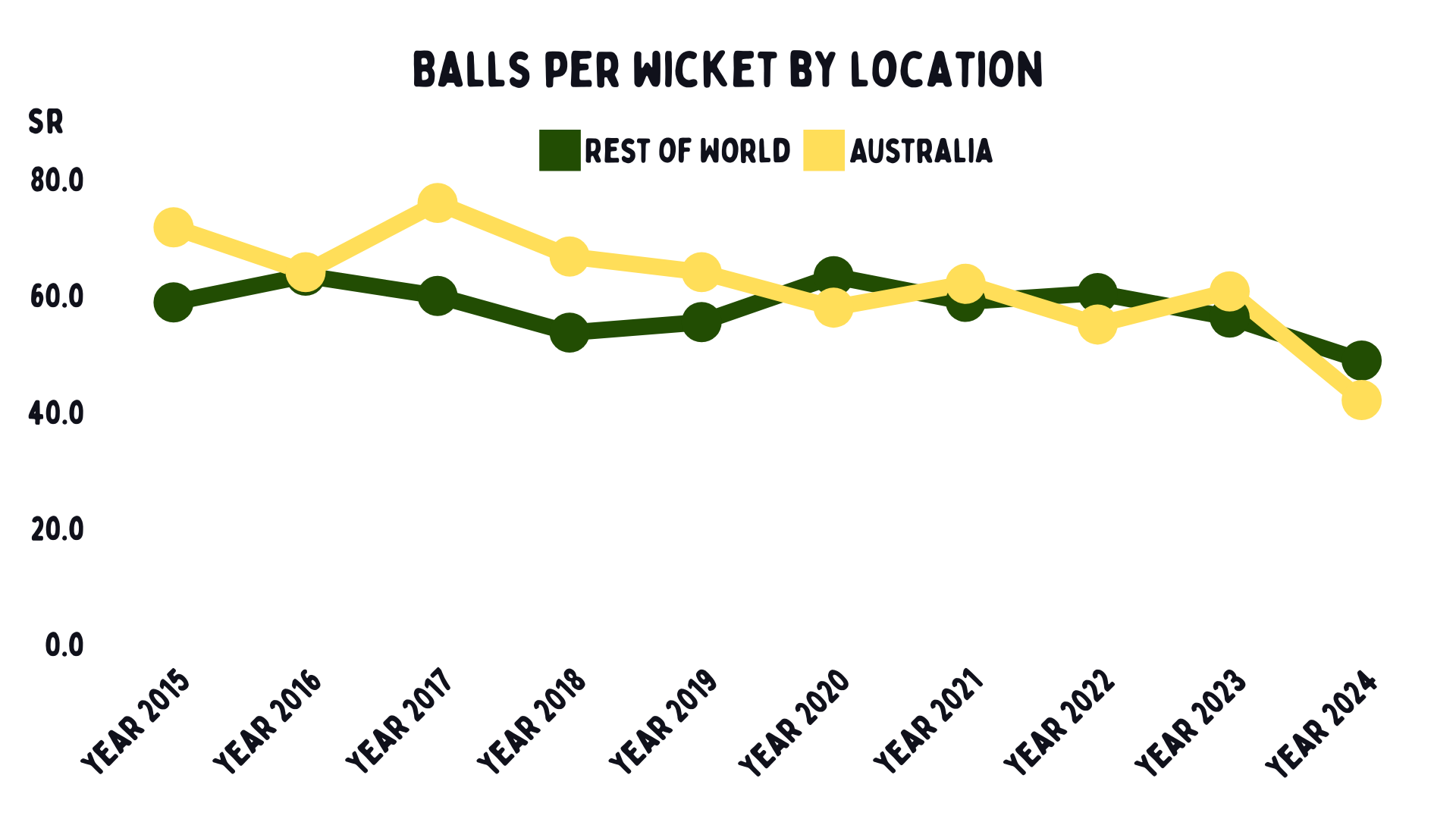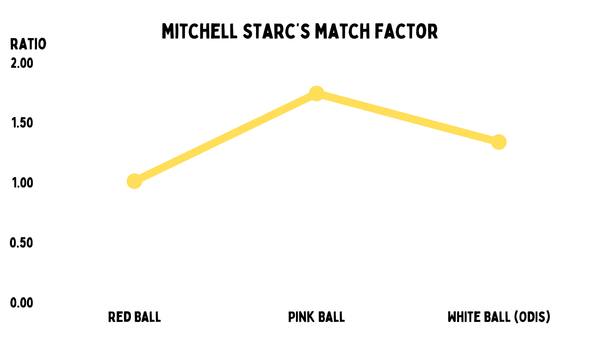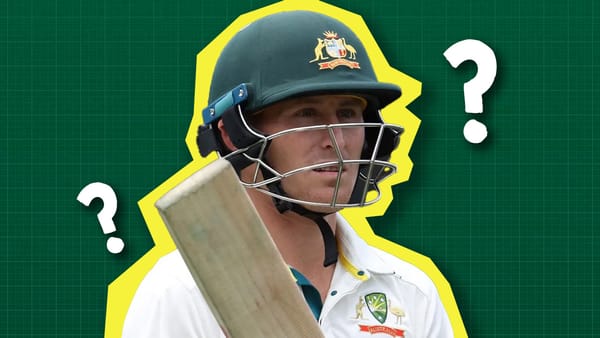How did 17 wickets happen in one day?
Wickets, wickets, wickets. The story of modern Test cricket.

This is what was supposed to happen today. Perth is a bowling pitch. But on day one, you score a lot of runs. The bowlers come back into it on day two, though it still remains a batting wicket. Then we get to the snake cracks, truly the worst kind of cracks. And by the time the wicket opens up, run-scoring is extremely difficult.
The curator thought that he must fix this. With rain around, he decided to keep the moisture in the surface just a little bit longer. A touch of green grass out there, so that later in the match we would have some good batting conditions.

But we got full wickets, straight wickets, short wickets, seam wickets, grassy wickets, fast wickets, bouncy wickets, skiddy wickets.

The two number threes faced 75 balls while combining for two runs. Marnus was playing and missing like that was his intention. People were talking about defensive techniques, but the ball was seaming around 0.8 degrees for most of the day. And let me explain that to you. At one degree, it's unplayable, and it was well above that consistently.
It would be tough to face a first-class medium pacer in these conditions. The batters in this match had to do it against Josh Hazlewood and Jasprit Bumrah. How do you get 17 wickets in one day? The answer is, easily.
A lot of wickets have been falling in Australia. This isn't the case traditionally. In the olden days, Australian batters averaged above 50 and snarled through gritted, gnarled moustaches at anyone who averaged under 40. Now, just staying in is an issue. Around 2015, you could see how many extra balls batters got on Australian wickets—sometimes upto 15 more per dismissal. It was a different world then. Everything has changed now.

In 2020, we had the first year with the new Kookaburra ball, with its reinforced seam and extra lacquer. Since then, batting in Australia has been hard. In fact this year, it is even worse. Maybe it is that extra pronounced seam that is hitting the harder wickets that is doing the damage. But it doesn’t matter. The Perth curator put in a touch of grass to scare off the snake cracks. Now, it doesn’t matter if the wicket is good for batting on day three, as we may not make it that far.

And if you are thinking that this is just happening to overseas players, then you’ve missed the recent batting drought of the Aussies. Why couldn't they find an opener? Usman Khawaja has been podcasting about this—batting in Shield cricket has been a challenging task. That new ball with result pitches means scoring runs while batting in the top three is impossible. Nathan McSweeney doesn’t make a lot of runs at three, he makes them at four, and even more at five. He is opening for Australia in a Test match because of the runs he has made down the order.
The bad news is that the same thing is happening to the Test team. Khawaja has seemingly run dry after another great three year period. People used to say Marnus only made runs when he was dropped. India would have had to drop him 17 times today for him to make 30. Steve Smith was in a form dip at number four, he opened, got worse, came back to number four and made a golden duck. Travis Head was a WTC final star, but he’s struggled in the last 20 innings. Alex Carey was about to be dropped before a career-saving 98* against New Zealand. We have Pat Cummins on this list for scale, and because his batting isn’t really that much worse than the others.

That is where Australian cricket is right now. But then, this is where everyone is. Test batting hasn’t been down this bad since World Series cricket seemed to inspire a funk in the late 1970s. In the 1950s, no one wanted to score, and no one could. The last time batting was majorly worse against pace bowling than it is now was before World War I.

The pace playing pandemic is legit. The wobbleball and Kookaburra’s supersonic ball have changed cricket as we know it. And it has happened at a time when players spend less time playing first-class cricket and more time switch hitting their reverse scoop slogs. That is being blamed for this, but it is only part of the problem.
Look at India’s first three wickets. Yashasvi Jaiswal and Devdutt Padikkal were late on their shots in Perth, which is like saying water is wet. And Kohli was out with extra bounce, which is again very normal. When batters did defend well, they were stuck without any scoring options. And all the attacking ones seemingly led to more wickets.
When it comes down to it, even before batters started playing T20 cricket, we could track ball movement. And when it moves this much, at this pace, against these bowlers, what are you supposed to do? In Perth, a little bit of seam is going to feel like a load, because you have no time. Today, only Rishabh Pant looked like he had any, despite playing unconventional shots.

Jasprit Bumrah is like a functional AI that mops up information quickly, but also knows the number of Rs in strawberry. He looked at the Australian bowling and figured that they were 7 to 8 centimetres too short. And he was right.

Josh Hazlewood spent a couple of years getting better at white ball cricket, and became great at that. This year, no one has been able to survive against his bowling in Test cricket.

No one knew which Mitchell Starc was going to turn up. Was it the Test bowler who had been fading, or the guy who looked fresh and firing early in the Australian summer? It turns out it might not have mattered, as this is his favourite wicket in Australia to bowl with the new ball. He may not have even seen the grass.

But maybe the real story today is Mitch Marsh. He spent about half an hour practicing at lunch because his body had to be stretched and loosened just so he could bowl again. This was only his second spell in professional cricket since April. When he bowled that time in the IPL, he got injured. Today, he looked absolutely fine. He took two victims in five overs. At a certain point, it felt like it it didn't matter who was bowling, they were just gonna get someone out.

Mohammed Siraj looked at this wicket and felt an inner warmth that he hasn’t in a long time. Harshit Rana bowled a dream ball on debut. 17 wickets fell today, and Pat Cummins was the worst of the seamers.
Wickets, wickets, wickets. The story of modern Test cricket.




